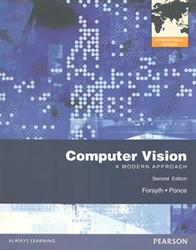An Introduction to 3D Computer Vision Techniques and Algorithms (Hardcover)
暫譯: 3D電腦視覺技術與演算法入門(精裝版)
Boguslaw Cyganek, J. Paul Siebert
- 出版商: Wiley
- 出版日期: 2009-03-03
- 售價: $6,540
- 貴賓價: 9.5 折 $6,213
- 語言: 英文
- 頁數: 504
- 裝訂: Hardcover
- ISBN: 047001704X
- ISBN-13: 9780470017043
-
相關分類:
Algorithms-data-structures、Computer Vision
無法訂購
買這商品的人也買了...
-
 機器學習:類神經網路、模糊系統以及基因演算法則, 2/e
機器學習:類神經網路、模糊系統以及基因演算法則, 2/e$350$315 -
 Linux 驅動程式, 3/e (Linux Device Drivers, 3/e)
Linux 驅動程式, 3/e (Linux Device Drivers, 3/e)$980$774 -
 C++ Primer, 4/e (中文版)
C++ Primer, 4/e (中文版)$990$891 -
 人工智慧:智慧型系統導論 (Artificial Intelligence: A Guide to Intelligent Systems, 2/e)
人工智慧:智慧型系統導論 (Artificial Intelligence: A Guide to Intelligent Systems, 2/e)$520$468 -
 Java 編程語言 (The Java Programming Language, 4/e)
Java 編程語言 (The Java Programming Language, 4/e)$820$697 -
 Introduction to Machine Learning, 2/e (Hardcover)
Introduction to Machine Learning, 2/e (Hardcover)$1,350$1,323 -
 Real-Time Rendering, 3/e (Hardcover)
Real-Time Rendering, 3/e (Hardcover)$4,300$4,085 -
 Learning OpenCV: Computer Vision with the OpenCV Library (Paperback)
Learning OpenCV: Computer Vision with the OpenCV Library (Paperback)$1,790$1,701 -
 精通 Windows API 函數、介面、程式設計實例
精通 Windows API 函數、介面、程式設計實例$640$506 -
 Linux 裝置驅動程式之開發詳解
Linux 裝置驅動程式之開發詳解$780$616 -
 3D 繪圖程式設計:使用 Direct3D 10/9 與 OpenGL 2.0
3D 繪圖程式設計:使用 Direct3D 10/9 與 OpenGL 2.0$700$553 -
 最新 Windows 程式設計實例入門-Visual C++ 實作 (增訂三版)
最新 Windows 程式設計實例入門-Visual C++ 實作 (增訂三版)$490$382 -
 iPhone SDK 開發範例大全 (The iPhone Developer's Cookbook: Building Applications with the iPhone SDK)
iPhone SDK 開發範例大全 (The iPhone Developer's Cookbook: Building Applications with the iPhone SDK)$620$527 -
 建構嵌入式 Linux 系統 (Building Embedded Linux Systems, 2/e)
建構嵌入式 Linux 系統 (Building Embedded Linux Systems, 2/e)$780$616 -
 精通 Visual C++ 視訊 / 音訊編解碼技術
精通 Visual C++ 視訊 / 音訊編解碼技術$650$514 -
 Google Android SDK 開發範例大全
Google Android SDK 開發範例大全$750$593 -
 Fedora 11 Linux 實務應用
Fedora 11 Linux 實務應用$650$553 -
 OpenGL Programming Guide: The Official Guide to Learning OpenGL, Versions 3.0 and 3.1, 7/e (Paperback)
OpenGL Programming Guide: The Official Guide to Learning OpenGL, Versions 3.0 and 3.1, 7/e (Paperback)$2,260$2,147 -
 Windows 應用程式開發經典 (Windows via C/C++, 5/e)
Windows 應用程式開發經典 (Windows via C/C++, 5/e)$950$751 -
 鳥哥的 Linux 私房菜-基礎學習篇, 3/e
鳥哥的 Linux 私房菜-基礎學習篇, 3/e$820$648 -
 Google Android SDK 開發範例大全 2
Google Android SDK 開發範例大全 2$890$703 -
 $990Machine Learning: An Algorithmic Perspective (Hardcover)
$990Machine Learning: An Algorithmic Perspective (Hardcover) -
 深入淺出 Android 系統原理及開發要點
深入淺出 Android 系統原理及開發要點$450$351 -
 $1,680Computer Vision: Algorithms and Applications (Hardcover)
$1,680Computer Vision: Algorithms and Applications (Hardcover) -
 Computer Vision: A Modern Approach, 2/e (IE-Paperback)
Computer Vision: A Modern Approach, 2/e (IE-Paperback)$1,250$1,225
商品描述
This book provides a comprehensive introduction to the methods, theories and algorithms of 3D computer vision. Almost every theoretical issue is underpinned with practical implementation or a working algorithm using pseudo-code and complete code written in C++ and MatLab®. There is the additional clarification of an accompanying website with downloadable software, case studies and exercises. Organised in three parts, Cyganek and Siebert give a brief history of vision research, and subsequently:
- present basic low-level image processing operations for image matching, including a separate chapter on image matching algorithms;
- explain scale-space vision, as well as space reconstruction and multiview integration;
- demonstrate a variety of practical applications for 3D surface imaging and analysis;
- provide concise appendices on topics such as the basics of projective geometry and tensor calculus for image processing, distortion and noise in images plus image warping procedures.
An Introduction to 3D Computer Vision Algorithms and Techniques is a valuable reference for practitioners and programmers working in 3D computer vision, image processing and analysis as well as computer visualisation. It would also be of interest to advanced students and researchers in the fields of engineering, computer science, clinical photography, robotics, graphics and mathematics.
商品描述(中文翻譯)
計算機視覺涵蓋了整合視覺系統的建構以及將視覺應用於現實世界重要問題的過程。創建3D模型的過程仍然相當困難,需要對相機位置進行機械測量或手動對齊場景的部分3D視圖。然而,使用算法,可以對場景的立體對圖像集合進行處理,然後自動生成一個照片真實感且幾何上準確的數位3D模型。
本書提供了3D計算機視覺方法、理論和算法的全面介紹。幾乎每個理論問題都以實際實現或使用C++和MatLab®編寫的完整代碼的工作算法為基礎。還有一個附帶網站的進一步說明,該網站提供可下載的軟體、案例研究和練習。全書分為三個部分,Cyganek和Siebert簡要回顧了視覺研究的歷史,隨後:
- 提出基本的低階影像處理操作以進行影像匹配,包括專門針對影像匹配算法的獨立章節;
- 解釋尺度空間視覺,以及空間重建和多視角整合;
- 演示各種3D表面成像和分析的實際應用;
- 提供有關投影幾何學和影像處理的張量微積分基礎、影像中的失真和噪聲以及影像變形程序等主題的簡明附錄。
《3D計算機視覺算法與技術導論》是從事3D計算機視覺、影像處理和分析以及計算機視覺化的實務工作者和程式設計師的重要參考資料。對於工程、計算機科學、臨床攝影、機器人技術、圖形學和數學等領域的高級學生和研究人員也將具有興趣。









